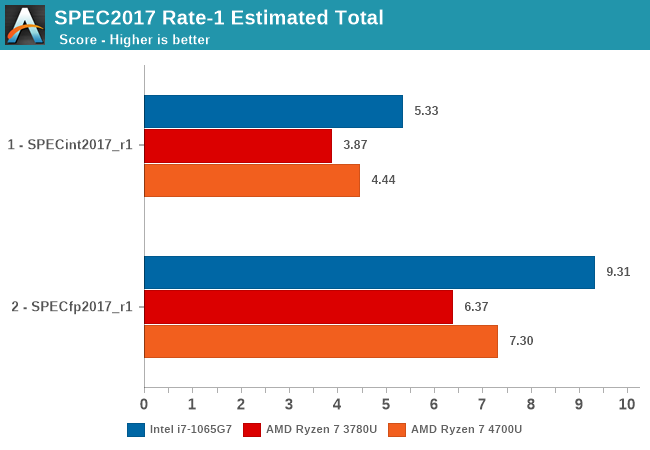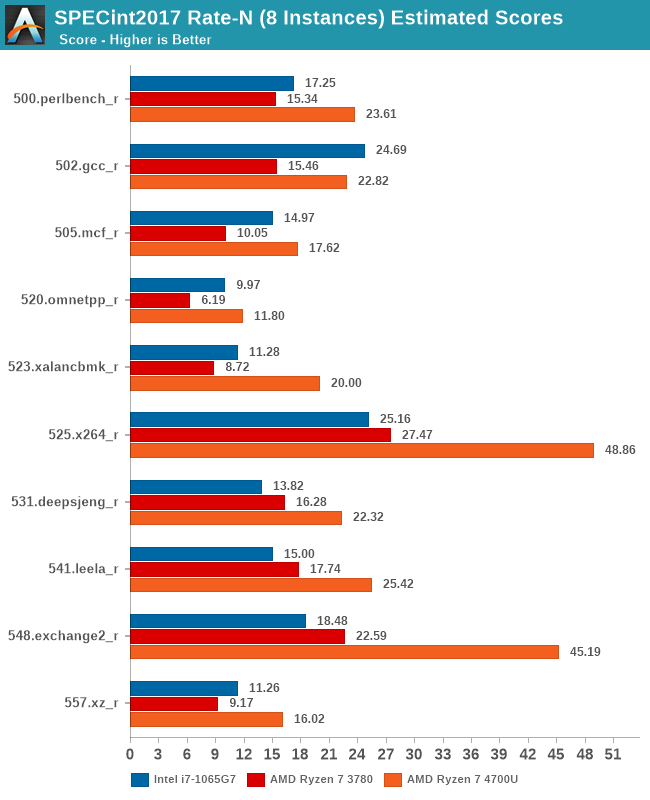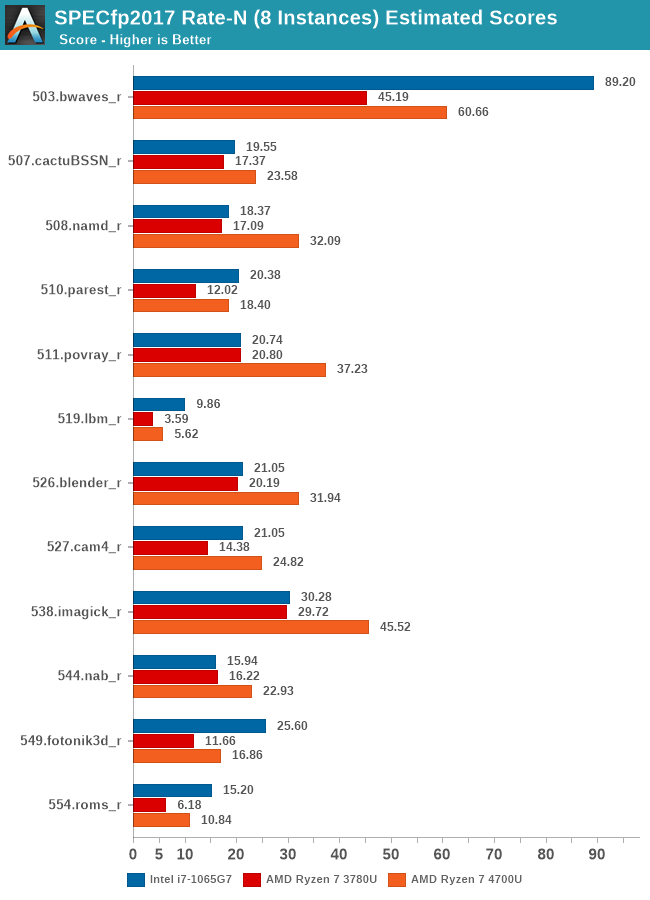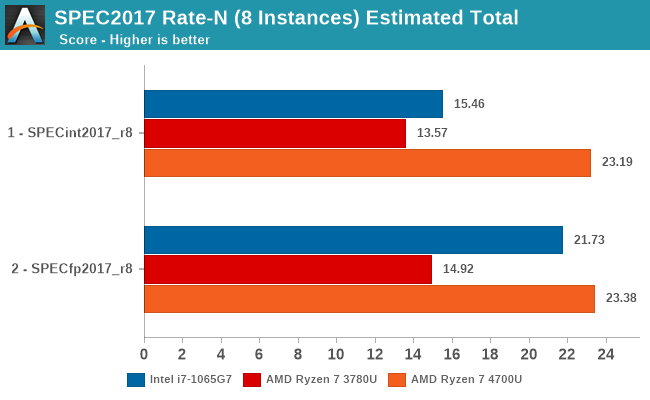The Acer Swift 3 SF314 Notebook Review: Swift Gets Swifter With Ryzen 4000
by Brett Howse & Andrei Frumusanu on May 5, 2020 8:00 AM ESTSection by Andrei Frumusanu
SPEC: Renoir vs Picasso vs Ice Lake
Kicking off our look at performance, let's start with SPEC and analyzing how AMD managed to increase the performance against Picasso with its first-generation Zen cores. The newer generation Renoir with Zen2 cores should in theory see more significant performance upgrades thanks to the improved IPC of the new microarchitecture – but today’s 4700U also is just a mid-tier part with a lower 15W TDP as well as “just” featuring DDR4-3200 – not the fullest memory configuration possible as the SoC also support LPDDR4X up to 4266 MHz.
For our SPEC harness, We’re testing under WSL1 in Windows due to simplicity of compilation and compatibility, and are compiling the suite under LLVM compilers. The choice of LLVM is related to being able to have similar code generation across architectures and platforms. Our compiler versions and settings are as follows:
clang version 8.0.0-svn350067-1~exp1+0~20181226174230.701~1.gbp6019f2 (trunk) clang version 7.0.1 (ssh://git@github.com/flang-compiler/flang-driver.git 24bd54da5c41af04838bbe7b68f830840d47fc03) -Ofast -fomit-frame-pointer -march=x86-64 -mtune=core-avx2 -mfma -mavx -mavx2
Our compiler flags are straightforward, with basic –Ofast and relevant ISA switches to allow for AVX2 instructions.
Single-Threaded Performance

In SPECint2017, the new Zen2 based Ryzen 7 4700U is performing well, although the score increase compared to the last-generation 3780U aren’t as big for some workloads. As a reminder, the 3780U clocks up to 4.0GHz in terms of boost clocks while the 4700U clocks up to 4.1GHz. SMT being disabled on the 4700U should also give it a slight advantage in IPC over other Zen2 platforms given that it doesn’t have to statically share some core resources anymore in this mode.
Renoir showcases the biggest increases in workloads such as 548.exchange2_r and 525.x264_r which are back-end execution bound workloads, and the microarchitectural improvements here help a lot.
On the other hand, the weakest improvements are seen in workloads such as 520.omnetpp_r – this test is mostly memory latency bound and unfortunately the new chip here barely just matches its predecessor. The same can be said about 505.mcf_r where the improvements are quite meager.
The generational improvements here aren’t enough to catch up to Intel’s Sunny Cove cores in the Ice Lake i7-1065G7. Although that core might be running at higher single-core TDPs and power consumption, it still makes for a big gap in some of the more instruction pressure and cache pressure high workloads such as 500.perlbench_r and 502.gcc_r where the Intel chip still has a considerable lead in.

In SPECfp2017, these are floating point heavier test workloads. The generational increases here are also relatively smaller, with even an odd regression in 527.cam4_r. The Intel chip still has a lead across the board, and with particular large gaps in the more memory heavy workloads such as 519.lbm_r and 549.fotonik3d_r.

Overall, in terms of single-threaded performance, the Zen2 Renoir chip might seem a bit underwhelming, but when looking at the IPC improvement it’s actually not that far off from what’s expected of the new microarchitecture. In both SPECint and SPECfp we see a 12% performance per clock improvement, which is generally in line with Zen2’s generational improvements. As a reminder, the mobile chips here only feature a quarter the CCX L3 cache compared to its desktop counterparts, and that will result in smaller IPC gains, especially in memory heavy workloads.
AMD’s higher-end SKUs such as the 4900HS score slightly better due to the higher boost frequencies, but nothing significant enough to change the single-threaded competitive landscape; Intel still has a substantial advantage here thanks to a much stronger memory subsystem.
Multi-Threaded Performance
The multi-threaded performance comparison today is actually quite interesting just for the fact that the 4700U doesn’t feature SMT. Whilst it lacks multi-threading on the cores, it makes up for it by simply having 8 physical cores on the chip, double that of Picasso-based SoCs as well as Intel’s latest Ice Lake CPUs. Again, performance here will be strongly impacted by the TDP as well as cooling of the systems. Both AMD parts are 15W TDP designs, while the Intel chip sustains 25W.

The resulting multi-threaded performance is quite varied across the benchmarks. What immediately stands out is that in purer execution heavy workloads the new Renoir chip pretty much demolishes its predecessor as well as the competition. This makes sense given that Zen2 has good execution resources and Renoir has double the physical core count to scale up performance.
Renoir’s performance here is very good across most workloads, but there’s a few workloads where Intel’s Ice Lake CPU comes closes or beats it even (502.gcc_r) – again these are the workloads that are most memory intensive.

SPECfp across 8 instances again shows similar results. Renoir fares extremely well across execution bound workloads, but this time around loses a lot more often against the Ice Lake chip in memory-bound workloads even though it has a 2x core count advantage.
The chip’s performance in memory-bandwidth heavy 519.lbm_r is particularly odd as it manages to fare worse than single-core results of a desktop Zen2 based system, and again far behind the Ice Lake counterparts.

Overall, AMD’s 4700U’s multi-threaded performance is fantastic in areas where it should matter most in a laptop-based system. The 2x core count advantage more than makes up for the lack of SMT, and workloads such as rendering and other creative tasks are the platform’s strong-points. In more memory-heavy workloads, performance doesn’t scale all that well as clearly the new chip still has a big weakness in its memory subsystem – scientific workloads or code compiling won’t scale nearly as well.
We have to wonder how Renoir will fare on an LPDDR4X configured system – unfortunately we haven’t been able to test such a platform yet. Overall, the 4700U seems like an excellent chip given its 15W TDP, but let’s see how it performs in our system benchmark suite…










191 Comments
View All Comments
LaMpiR - Friday, May 8, 2020 - link
So, a 649$ laptop costs in Europe 890$. How is this possible?neblogai - Saturday, May 9, 2020 - link
Something was probably wrong with the sample Anandtech got. Here is a video of FarCry5- Swift 3 4700U temps stay at nice and cool ~69C even in the long and action packed scene: https://youtu.be/8A2XFdAZLPQ . There is also another test with a 4500U model from the same channel- no temperature issues there either, nor in any of the ~20 games tested. Other channels, like Dave Lee, also say that cooling is just so capable and quiet, that Acer should have upped cTDP higher.Oxford Guy - Saturday, May 9, 2020 - link
Maybe it's just me, but the whole article seems very deceptive.The headline should be: "The Acer Swift 3 SF314 Notebook Review: Swift Gets Slower With Kneecapped Ryzen 4000"
The little TDP graphic should be 8+ watts, not 15.
neblogai - Sunday, May 10, 2020 - link
It is just you. Acer would not be wrong to call Intel models 'Swift 3', and AMD models - 'Swifter 3'.watzupken - Sunday, May 10, 2020 - link
The throttling is to be expected when you see a 1.2kg laptop. Where can they cut in order to lose few hundred grams, when the battery size is the same? Surely its got to be the cooling solution. If you are looking for performance, these ultra slim laptops are not for you. The same problem plagues Intel based laptops as well. As PC maker/ manufacturers go crazy about cutting weight and size of laptops, a lot of these thin laptops suffer from thermal throttling, poor upgradeability and missing port convenience.In this case, I think there may be something wrong with the fan curve and should be resolved through some software updates. The cooling solution looks normal to me after cracking open a few of these laptops with low power processors. Only observation is that the heatsink is getting thinner over the years, which will certainly impact cooling. Mid end models should have a longer heatsink with slightly bigger fan to cover the longer heatsink, while high end models may end up with dual heatsink and fan cooling solution to get around the slimness.
Oxford Guy - Monday, May 11, 2020 - link
Yes, it's "just me" because apparently 8 watts is "Swifter" than the 15 it's supposed to run at.At least the 15W graphic appears to have been removed. That's something.
Oxford Guy - Monday, May 11, 2020 - link
"The throttling is to be expected when you see a 1.2kg laptop. Where can they cut in order to lose few hundred grams, when the battery size is the same? Surely its got to be the cooling solution. If you are looking for performance, these ultra slim laptops are not for you."I don't buy this excuse.
When a company sells a product it shouldn't be a bait and switch deal.
If Acer wants to post "8+ watts" as the TDP of the CPU in a prominent place that's one thing. If it lists 15W and/or just the CPU model then that's not good enough.
Moreover, it should be made clear to the consumer that the CPU is throttled to get to that 8 watts, not that it's just so efficient it can function at 8 watts to do the equivalent of what should take 15 for the same CPU because of something special about the machine's design.
If the machine can't handle a 15 watt CPU then it should be throttled to what it can handle and that should be the spec sold to consumers, not the spec it can't handle.
ReallyBigMistake - Sunday, May 17, 2020 - link
"Key to this is a much-needed jump from GlobalFoundries' 12nm process to TSMC's class-leading 7nm process"I am calling it but GF days are numbered.
Cirecomputers12 - Sunday, June 7, 2020 - link
What you guys don't get is the internals are great at the price of a very CRAP display. Just look up the srgb and the Adobe rgb its terrible. The brightness nits are 250 which is pretty much as dark as you can go with laptops. SO if the display doesn't mean that much, this an awesome deal. If it does all the power in the world isn't going to make that Display any better. It's also made out of plastic......It's up to you ......AdriaticAdrian2 - Tuesday, April 27, 2021 - link
Does someone know if I charge it with anything lower than 65w through USB-C? I have it but I don't want to buy anything that will not work